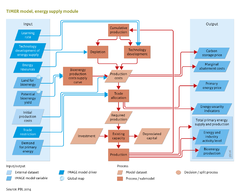Energy supply: Difference between revisions
Jump to navigation
Jump to search
m (Text replace - "|Status=On hold" to "") |
No edit summary |
||
| Line 1: | Line 1: | ||
{{ComponentTemplate2 | {{ComponentTemplate2 | ||
|Application=Roads from Rio+20 (2012); | |Application=Roads from Rio+20 (2012); | ||
|IMAGEComponent=Scenario drivers; Land cover and use; Crop and grass; Emissions; Climate policy; Atmospheric composition and climate; Energy demand; Energy conversion; Energy supply and demand; | |IMAGEComponent=Scenario drivers; Land cover and use; Crop and grass; Emissions; Climate policy; Atmospheric composition and climate; Energy demand; Energy conversion; Energy supply and demand; | ||
| Line 15: | Line 11: | ||
==Links to other parts of the model== | ==Links to other parts of the model== | ||
The supply of energy is assumed to be a function of total demand in the sense that all demand is always met. Because regions can usually not supply all demand, energy carriers such as coal, oil and gas are widely traded. The supply model influences developments in the demand and conversion models via prices: primary fuel prices influence investment decisions in end-use and energy conversion. Linkages to other parts of IMAGE are the available land for bio-energy production and the emissions of greenhouse gas and air pollutants (partly related to supply) and the use of land for bio-energy production (no account is made for land use for other energy forms). Several key assumptions determine the long-term behavior of the various energy supply submodels. There are mostly related to technology development and the resource base. The various links are indicated in the table below. | The supply of energy is assumed to be a function of total demand in the sense that all demand is always met. Because regions can usually not supply all demand, energy carriers such as coal, oil and gas are widely traded. The supply model influences developments in the demand and conversion models via prices: primary fuel prices influence investment decisions in end-use and energy conversion. Linkages to other parts of IMAGE are the available land for bio-energy production and the emissions of greenhouse gas and air pollutants (partly related to supply) and the use of land for bio-energy production (no account is made for land use for other energy forms). Several key assumptions determine the long-term behavior of the various energy supply submodels. There are mostly related to technology development and the resource base. The various links are indicated in the table below. | ||
|ComponentCode=ES | |||
|AggregatedComponent=Energy supply and demand | |||
|FrameworkElementType=pressure component | |||
}} | }} | ||
Revision as of 14:21, 10 January 2014
| Component is implemented in: |
|
| Related IMAGE components |
| Projects/Applications |
| Key publications |
Key policy issues
- How can energy resources be exploited to meet future primary energy demand?
- How can energy supply and demand be balanced between world regions, and how will this effect security of supply?
- How rapidly can the transition to more sustainable energy supply be made?
